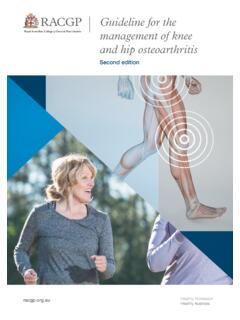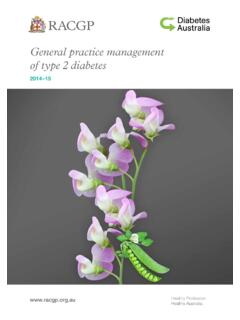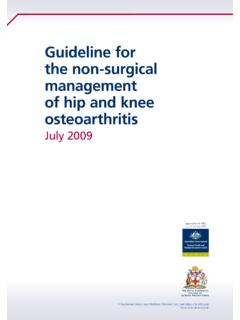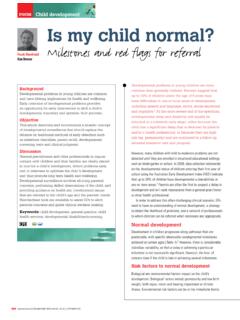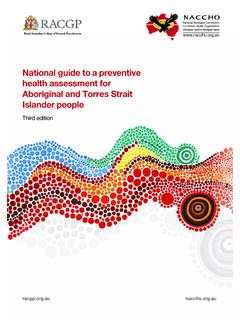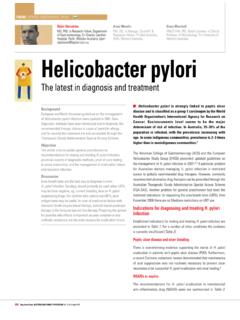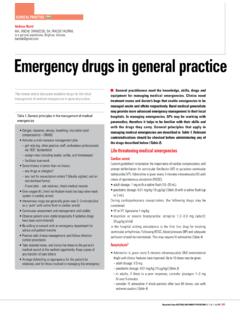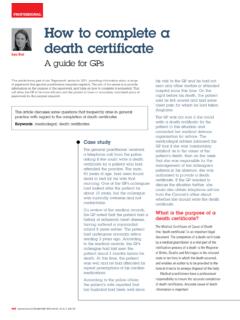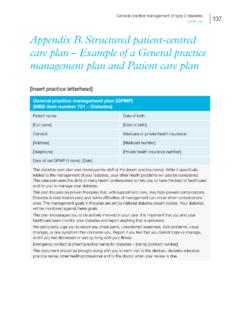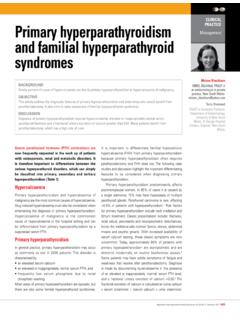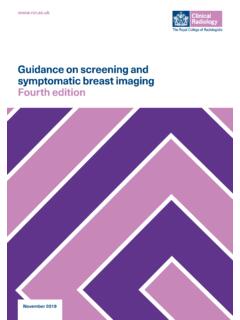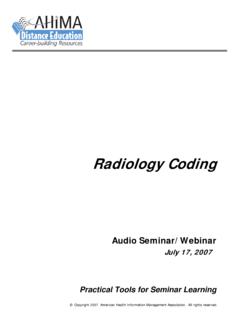Transcription of Management of benign breast conditions
1 Reprinted from Australian Family Physician Vol. 34, No. 4, April 2005 4 253 This is the second article in a series on breast disorders with an emphasis on diagnosis and Management in the general practice setting. This article provides an overview of the investigation of patients with a breast symptom and discusses the assessment and Management of benign breast lesions including localised nodularity, fibroadenomas and breast many women, a great deal of anxiety is associated with experiencing a breast change. While breast cancer is a common disease, affecting up to one in 11 Australian women1 in their lifetime, the majority of breast lumps are benign . Much of the general practitioner s role is to exclude cancer, provide an explanation of the nature of the condition, and educate and reassure the nodularityLocalised nodularity is a common finding in patients who present complaining of a lump.
2 It is a reflection of normal lumpy or nodular breast tissue that is a common clinical finding, especially in young women. It is generally found in the upper outer quadrants of the breasts. Nodularity is usually a physiological change. However, a small but important proportion of breast cancers may present as localised nodularity. InvestigationTriple testing a combination of clinical examination, imaging, and nonsurgical biopsy is essential for all women who have a significant clinical finding such as an asymmetrical thickening or a discrete palpable Nodularity in young women (<30 years) that is symmetrical and cyclical, may be managed with clinical surveillance with repeat examination in 2 3 months. Investigation may be performed if the lump has changed on review, or if at initial presentation the woman feels it is a definite new change in her breasts. Nodularity or thickening that is asymmetric, or is a new finding in older women (>30 years), requires investigation with mammography and ultrasound.
3 Fine needle biopsy or core biopsy should also be considered, even in the presence of normal imaging, if there is any clinical concern. Biopsy or referral to a breast surgeon is warranted where clinical findings are suspicious of malignancy. Close clinical follow up is an important part of the Management of nodularity, so that an enlarging mass of nodularity or development of associated findings (eg. skin or nipple changes) is detected. These changes can then be further fibroadenoma is a focal area of change in the breast tissue that occurs due to overgrowth of benign breast elements, both stroma and epithelium. Fibroadenomas account for about 12% of all symptomatic breast They have a peak incidence in the 21 25 years age group. Fewer than 5% occur in women over the age of 50 The cause of fibroadenomas is unknown, however, hormonal factors are thought to be important as fibroadenomas are known to fluctuate during the menstrual cycle and during pregnancy.
4 Fibroadenomas can be solitary or multiple, palpable or impalpable. While GPs have long been involved in managing women with palpable fibroadenomas, they are increasingly involved in investigating and managing impalpable probable fibroadenomas, picked up on imaging performed for other reasons. Palpable fibroadenomas on clinical examination are classically round or oval, firm and rubbery, smooth, and very mobile. Although they are not generally painful, they may be tender, particularly Brennan, BMed, FRACGP, DFM, , FASBP, is a breast physician, NSW breast Cancer Institute, Westmead Hospital, New South Wales. Houssami, MBBS, FAFPHM, FASBP, PhD, is Associate Clinical Director, NSW breast Cancer Institute, Westmead Hospital, Honorary Senior Lecturer, Screening and Test Evaluation Program, School of Public Health, The University of Sydney, New South French, MBBS, FRACS, is a breast and endocrine surgeon, NSW breast Cancer Institute, Westmead Hospital, New South of benign breast conditionsPart 2 breast lumps and lesionsBreast series CLINICAL PRACTICE254 3 Reprinted from Australian Family Physician Vol.
5 34, No. 4, April 2005 Imaging featuresFibroadenomas vary in their imaging appearance and are often not seen on mammography as they may have the same density as the surrounding breast parenchyma. When they are seen on mammography, they appear as a well defined density that may be lobulated and contain calcification (typically coarse or popcorn-like ). On ultrasound, a fibroadenoma may appear as a well circumscribed, homogeneous, hypoechoic lesion, classically with edge shadowing; gentle lobulations may be present. In some cases, coarse calcification can be seen within the lesion on diagnosesThe differential diagnoses of fibroadenoma include: phyllodes tumours: can have the same clinical and imaging features as a fibroadenoma, may be benign or malignant, and are always managed with surgical excision breast cancer: high grade, cellular cancers, particularly medullary carcinomas, can mimic fibroadenomas other benign breast lesions: when small, fibroadenomas can be difficult to distinguish from cysts, papillomas, and entrapped fat on suspected fibroadenoma that is palpable or shows atypical features on clinical or imaging assessment requires pathological diagnosis with fine needle aspiration biopsy, core biopsy, or surgical excision.
6 Because of the high proportion of fibrous tissue relative to epithelial tissue in fibroadenomas, fine needle aspiration biopsy may be insufficient for diagnosis. Increasingly, core biopsy is used in the diagnosis of fibroadenomas. Management If benign on triple testing, fibroadenomas may be managed either with surgical excision or with ongoing clinical and imaging surveillance. The Management plan is determined mainly by the age of the patient and patient preference (Table 1).3 breast cystsA breast cyst is a localised collection of fluid in the breast . They are very common and can occur in women of any age, with a peak incidence in the 30 50 years age group. Approximately 7% of women will present with a palpable cyst at some time in their Fluid is constantly being produced and reabsorbed in the milk ducts and lobular acini of the breast . When a duct becomes blocked, or the amount of fluid secreted exceeds the amount absorbed, fluid accumulates causing cysts.
7 Cysts can be single or multiple and appear to be hormonally responsive, often fluctuating during the menstrual cycle. They tend to disappear after menopause, although they can persist or occur de novo in postmenopausal women on hormone therapy. Most breast cysts are impalpable and asymptomatic and are an incidental finding on routine imaging. Cysts that are apparent clinically, classically present as lumps that are smooth, soft to firm, mobile, and sometimes tender. Cysts under tension can be firm to hard on examination and may be associated with significant tenderness. A cluster of cysts can present as a tender area of featuresCysts may not be visible on mammography. Ultrasound is generally a better tool for diagnosing and characterising cysts, and for distinguishing cysts from solid lesions. Cysts seen on mammography classically appear as well defined round densities that may be multiple. On ultrasound, typical cysts are well defined round or oval anechoic (black) lesions.
8 Cysts that show atypical features (features other than those of a simple or typical cyst) such as internal echoes or thick walls, may be difficult to distinguish from solid lesions on Cysts that are asymptomatic and show typical benign cystic features on imaging require no treatment. The patient can be reassured that the lesions are not malignant, and that they do not significantly increase the chance of developing breast cancer. They require no specific follow up unless they become symptomatic . Women with cysts that are symptomatic (causing a lump or significant discomfort) can be offered aspiration for symptomatic relief, either under clinical or ultrasound guidance. A palpable lump that has the features typical of a simple cyst on ultrasound does not require aspiration for confirmation of diagnosis. Cystic lesions that show atypical or complex features on imaging (eg. internal echoes, thick walls, or an irregular margin), even if asymptomatic, may require aspiration.
9 Aspiration is considered when a possible cystic lesion cannot be distinguished from a solid lesion on imaging. In this situation, aspiration is usually performed under ultrasound guidance and a sample of the aspirated material should be sent for cytological role of cytology and surgeryFluid from cysts that are aspirated to relieve symptoms do not need to be sent for cytological assessment if: the clinical lump and imaging lesion resolves fully with aspiration, or the cyst fluid is not macroscopically blood from atypical cysts should be sent for cytological assessment unless the lesion drains fully with aspiration, leaving no sonographic abnormality Surgery is rarely indicated for breast cysts. It is reserved for: palpable cysts that recur despite repeated aspiration cysts that appear to have an intra-cystic solid lesion on imaging, or lesions that do not resolve completely with aspiration and show atypical or suspicious cytology.
10 Are cysts cancerous? breast cysts are benign . Imaging, specifically ultrasound, can usually distinguish cysts from cancer. While some studies have suggested that women with palpable cysts may have an increased risk for subsequent development of breast cancer, the magnitude of risk is not considered to have clinical Cysts can present a challenge in detecting breast cancer as it can be difficult to find a malignant Clinical practice: Management of benign breast conditions Part 2 breast lumps and lesionsReprinted from Australian Family Physician Vol. 34, No. 4, April 2005 4 255lesion in a breast that contains multiple cysts. Patients who have multiple cysts may also become complacent about having breast lumps and delay seeking treatment for a new lump. Educating and reassuring the patient is very important in the Management of breast cysts, as most cysts are asymptomatic incidental findings on ultrasound that are unlikely to cause the patient any problems (see Patient education this issue).
